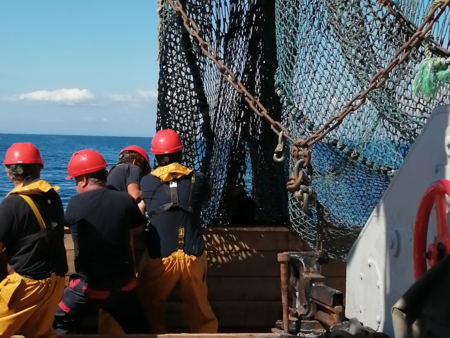ANEMOI (2023-2027)
Chemical emissions from offshore wind farms: assessing impacts, gaps and opportunities
Coordination Ifremer | Type de projet | Financeur | Durée du projet | Lien |
European | Interreg North Sea | 2023-2027 |
The primary aim of offshore wind farms (OWFs) is to produce renewable energy. OWFs contribute to UN sustainable development goals on clean energy and climate action and offer opportunities for spatial multi-use with nature conservation and aquaculture. These facilities are expected to play a fundamental role in the energy transition. However, the marine environment is a highly corrosive environment for steel constructions such as offshore wind turbines or platforms. Corrosion affects all parts of offshore wind turbines, especially in the submerged and in the tidal- and wave-affected splash zones. These zones are often protected by a combination of different corrosion protection systems including (organic) coatings (e.g. epoxy resins and polyurethane) and “sacrificial anodes” among others. Being in direct contact with seawater, these systems have potential for chemical emissions into the marine environment. The type and environmental impact of chemical emissions from OWFs have been largely overlooked to date, although the first investigations indicate that OWFs represent a source of chemical emissions, particularly inorganic chemicals. Very limited data exist on leached organic chemicals. Epoxy resins, widely used on OWF coatings, are suspected to be a source of certain toxic organics, like bisphenols and other plastic additives, but further experimental confirmation and a comprehensive characterization and quantification of these emissions are needed. Given the large global increase in the number of OWFs, a comprehensive assessment of their chemical emission should be performed, and transnational cooperation is required to minimise contaminant emissions and ensure a healthy ecosystem. The Interreg North-Sea project ANEMOI, named after the Greek wind gods, aims to fill these gaps by characterising chemical emissions from OWFs in the North Sea basin, assessing their impact on the marine ecosystem, evaluating opportunities for aquaculture at OWFs and proposing effective monitoring tools and reduction measures to ensure sustainable multi-use of the marine environment. IFREMER-CCEM is co-leading with The Royal Belgian Institute of Natural Sciences (RBINS) the project’s WP2 (Chemical and particulate emissions from OWFs). This WP proposes a number of multi-disciplinary activities (field and laboratory work) aiming at elucidating the chemical profiles emitted by operational OWFs in the North Sea region and their dispersion within and out of the OWF areas. IFREMER-CCEM will specifically focus on the development and application of target methods for the trace analysis or organic contaminants in sediment, water and selected marine organisms gathered on the OWFs and reference areas in the North Sea. Collaborations with WP3 (Impact of chemical leachates from OWFs on aquaculture products and marine life) are also foreseen.
Personnels Ifremer | Les partenaires |
C. Pollono (CCEM), N. Bely (CCEM) | ILVO (Belgium – Project coordinator); IFREMER (France); RBINS (Belgium); University of Antwerp (Belgium); POM-WVL (Belgium); BSH (Germany); HEREON (Germany); Technical University of Braunschweig (Germany); SINTEF OCEAN (Norway); NIOZ (Netherlands); Technical University of Denmark (Denmark) |
Résultats attendus :
Expected results are among others: (1) to establish a framework towards harmonisation of regulating chemical emissions in offshore wind parks; (2) to develop and implement a monitoring approach to identify and compare emissions in OWFs with different corrosion protection systems; (3) to identify, measure and model priority chemicals of concern in OWF areas; (4) To assess the opportunities, strengths, threats and weaknesses for aquaculture production at OWFs and the effects of OWF chemical emissions on the ecosystem; (5) to perform a risk evaluation of chemical emissions of OWFs towards the marine ecosystem and human health and development of risk mitigation measures.



